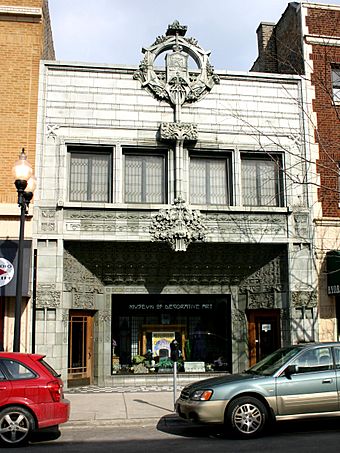Krause Music Store facts for kids
|
Krause Music Store
|
|
 |
|
| Location | 4611 North Lincoln Avenue Chicago, Illinois |
|---|---|
| Built | 1922 |
| Architect | William Presto (store) Louis Sullivan (facade) |
| NRHP reference No. | 06000452 |
Quick facts for kids Significant dates |
|
| Added to NRHP | May 31, 2006 |
The Krause Music Store is a very important building in Chicago, Illinois. It's known as a National Historic Landmark, which means it's a special place in American history. This building is famous because it was the very last project of a brilliant architect named Louis Sullivan. He was one of the greatest architects of the "Chicago School of Architecture."
Sullivan believed that a building's purpose should shape its design. He famously said, "form follows function." This means the way a building looks should come from what it's used for. The Krause Music Store shows this idea with its cool, curvy shapes and detailed window frames.
Contents
Designing a Unique Building
In 1921, a man named William P. Krause wanted a building for his home and a music shop. He hired his neighbor, William Presto, to design it. Years before, Presto had worked for Louis Sullivan. But by 1921, Sullivan wasn't getting many jobs. So, Presto asked his old boss, Sullivan, to design the front of the building.
Louis Sullivan's Final Masterpiece
Even though Louis Sullivan was not well and didn't have much money, he took the job. He used a special material called terra cotta to create the building's beautiful green front. Terra cotta is a type of baked clay. Sullivan designed the entire facade with amazing details, using shapes inspired by nature. These designs included both curvy and geometric patterns. The building was finished in 1922.
The Building's Many Lives
When it first opened, the Krause Music Store sold pianos and sheet music. It was also one of the first places to sell radios!
From Music to Funerals
Later, during the Great Depression, William Krause passed away. His family rented out the building and eventually sold it. For about 60 years, the building became a funeral home. During this time, it wasn't always well cared for. The beautiful terra cotta front was cleaned with acid, which unfortunately damaged its color. The basement was also changed to help with funeral services.
Restoration and Recognition
In 1977, the City of Chicago recognized how important the building was. They named its front a Chicago Landmark. This helped protect its unique design.
About 13 years later, a man named Scott Elliott opened an art gallery there. He worked to bring the front of the building back to its original look. Around the year 2000, a gift shop called The Museum of Decorative Arts used the space.
In 2005, Pooja and Peter Vukosavich bought the building. They carefully restored Sullivan's historic facade. They also updated the inside for their company, Studio V Design. Their work won several awards. In 2006, thanks to their efforts, the building was added to the National Register of Historic Places. This means it's officially recognized as a very important historical site in the United States.

